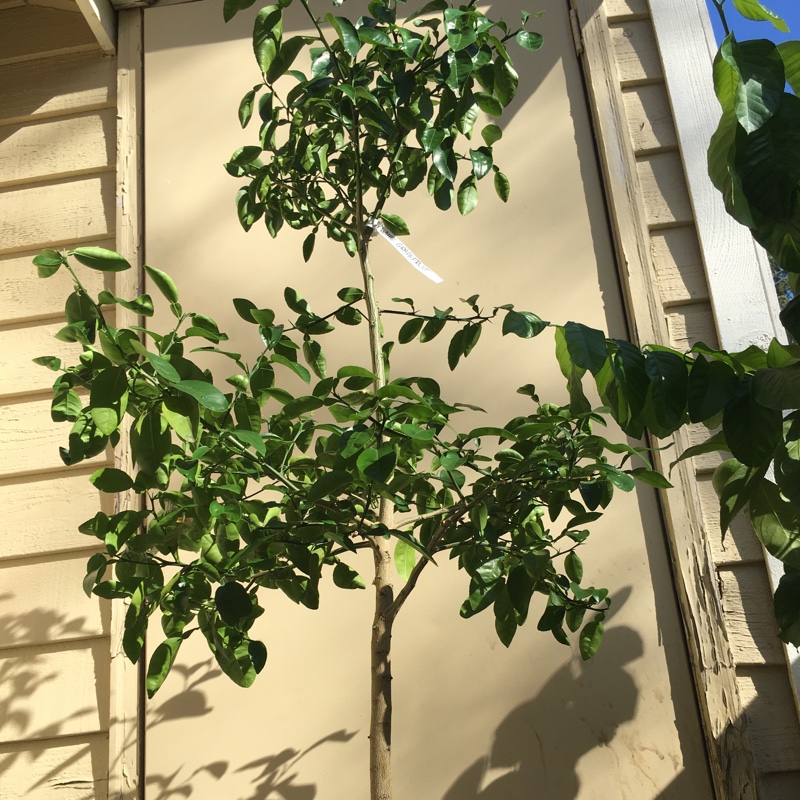
Citrus x paradisi 'Duncan'
Grapefruit Tree 'Duncan'
With handsome foliage and waxy white flowers, these tender evergreen shrubs and trees, make ideal conservatory plants. This group includes all popular citrus fruits, Lime, Lemon, Orange and Grapefruit. Most need a minimum winter temperature of 5 - 10C. The scented flowers appear in summer in a cool conservatory, but in ideal conditions, flowers are produced at intervals throughout the year. Plants may only reach half their maximum height when planted in containers. Grapefruit bears large rather 'Duncan' is a medium-sized, hybrid grapefruit tree which can grow to between 4.5 to 6m tall in cultivation. The fragrant white flowers usually grow in clusters of 2 to 20 and produce large globose to pear-shaped fruits that ripen to light yellow and are 10 to 15 cm in diameter.sour fruit.
Contributed by @ashleykay
-
Partial shade
-
Occasional watering
-
Not Frost hardy
-
Rich and free draining
Common name
Grapefruit Tree 'Duncan'
Latin name
Citrus x paradisi 'Duncan'
type
Evergreens
family
Rutaceae
ph
5.0 - 7.0 Acid - Neutral
Plant & bloom calendar
-
Best time to plant
full grown dimensions
 7.00 M
10.00 M
7.00 M
10.00 M
Citrus x paradisi 'Duncan'
With handsome foliage and waxy white flowers, these tender evergreen shrubs and trees, make ideal conservatory plants. This group includes all popular citrus fruits, Lime, Lemon, Orange and Grapefruit. Most need a minimum winter temperature of 5 - 10C. The scented flowers appear in summer in a cool conservatory, but in ideal conditions, flowers are produced at intervals throughout the year. Plants may only reach half their maximum height when planted in containers. Grapefruit bears large rather 'Duncan' is a medium-sized, hybrid grapefruit tree which can grow to between 4.5 to 6m tall in cultivation. The fragrant white flowers usually grow in clusters of 2 to 20 and produce large globose to pear-shaped fruits that ripen to light yellow and are 10 to 15 cm in diameter.sour fruit.
Planting young plants
From Early Spring TO Early Spring
Pot the tree in a large container filled with a mixture of 1 part each potting soil, organic compost and per-lite or vermiculite. Give the tree plenty of room to spread out and establish a healthy root system. Replant container plants every few years to prevent roots from becoming root bound.
Propagation by cuttings
From Early Summer TO Mid Summer
Take softwood cuttings from new growth early in the day in Summer. Cut, neatly, an 8" approx. piece of a non-flowering shoot, and remove the bottom leaves, leaving just the top 3 leaves. Trim the end of the cutting so that it is about 6" long, cutting neatly just below a leaf node. . Dip the bottom of the cutting in hormone rooting powder, and carefully place in a pot of cutting compost about 2 1/2" into the compost. Water, label, cover with a polythene bag, and place in a warm - 65 deg. to 70 deg. -, bright place, out of direct sunlight. Take the polythene bag off periodically for a while for ventilation (at least twice a week), and keep the compost moist, but not wet.
Propagating by seed
From Early Spring TO Late Winter
The pip of any type of citrus fruit can be grown in a pot of seed compost as long as the compost is kept moist - not wet - and the pot is placed in a warm environment. The compost needs to be at a temperature of no less than 60 deg., or germination may not occur, or the seedling may die.











